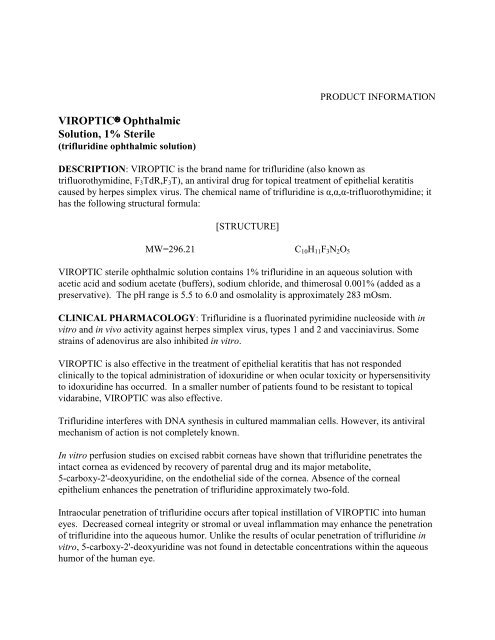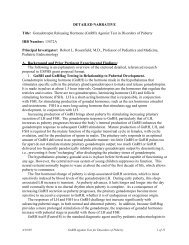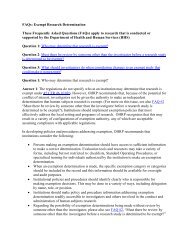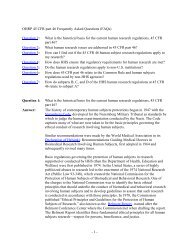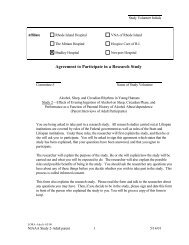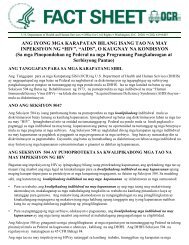VIROPTIC Ophthalmic Solution, 1% Sterile - HHS Archive
VIROPTIC Ophthalmic Solution, 1% Sterile - HHS Archive
VIROPTIC Ophthalmic Solution, 1% Sterile - HHS Archive
You also want an ePaper? Increase the reach of your titles
YUMPU automatically turns print PDFs into web optimized ePapers that Google loves.
PRODUCT INFORMATION <br />
<strong>VIROPTIC</strong> <strong>Ophthalmic</strong><br />
<strong>Solution</strong>, <strong>1%</strong> <strong>Sterile</strong><br />
(trifluridine ophthalmic solution)<br />
DESCRIPTION: <strong>VIROPTIC</strong> is the brand name for trifluridine (also known as<br />
trifluorothymidine, F 3 TdR,F 3 T), an antiviral drug for topical treatment of epithelial keratitis<br />
caused by herpes simplex virus. The chemical name of trifluridine is ,,-trifluorothymidine; it<br />
has the following structural formula:<br />
[STRUCTURE]<br />
MW=296.21 C 10 H 11 F 3 N 2 O 5<br />
<strong>VIROPTIC</strong> sterile ophthalmic solution contains <strong>1%</strong> trifluridine in an aqueous solution with<br />
acetic acid and sodium acetate (buffers), sodium chloride, and thimerosal 0.00<strong>1%</strong> (added as a<br />
preservative). The pH range is 5.5 to 6.0 and osmolality is approximately 283 mOsm.<br />
CLINICAL PHARMACOLOGY: Trifluridine is a fluorinated pyrimidine nucleoside with in<br />
vitro and in vivo activity against herpes simplex virus, types 1 and 2 and vacciniavirus. Some<br />
strains of adenovirus are also inhibited in vitro.<br />
<strong>VIROPTIC</strong> is also effective in the treatment of epithelial keratitis that has not responded<br />
clinically to the topical administration of idoxuridine or when ocular toxicity or hypersensitivity<br />
to idoxuridine has occurred. In a smaller number of patients found to be resistant to topical<br />
vidarabine, <strong>VIROPTIC</strong> was also effective.<br />
Trifluridine interferes with DNA synthesis in cultured mammalian cells. However, its antiviral<br />
mechanism of action is not completely known.<br />
In vitro perfusion studies on excised rabbit corneas have shown that trifluridine penetrates the<br />
intact cornea as evidenced by recovery of parental drug and its major metabolite,<br />
5-carboxy-2'-deoxyuridine, on the endothelial side of the cornea. Absence of the corneal<br />
epithelium enhances the penetration of trifluridine approximately two-fold.<br />
Intraocular penetration of trifluridine occurs after topical instillation of <strong>VIROPTIC</strong> into human<br />
eyes. Decreased corneal integrity or stromal or uveal inflammation may enhance the penetration<br />
of trifluridine into the aqueous humor. Unlike the results of ocular penetration of trifluridine in<br />
vitro, 5-carboxy-2'-deoxyuridine was not found in detectable concentrations within the aqueous<br />
humor of the human eye.
Systemic absorption of trifluridine following therapeutic dosing with <strong>VIROPTIC</strong> appears to be <br />
negligible. No detectable concentrations of trifluridine or 5-carboxy-2'-deoxyuridine were found <br />
in the sera of adult healthy normal subjects who had <strong>VIROPTIC</strong> instilled into their eyes seven <br />
times daily for 14 consecutive days. <br />
Clinical Studies: During a controlled multicenter clinical trial, 92 of 97 (95%) patients (78 of <br />
81 with dendritic and 14 of 16 with geographic ulcers) responded to therapy with <strong>VIROPTIC</strong> as <br />
evidenced by complete corneal re-epithelialization within the 14-day therapy period. Fifty-six of <br />
75 (75%) patients (49 of 58 with dendritic and 7 of 17 with geographic ulcers) responded to <br />
idoxuridine therapy. The mean time to corneal re-epithelialization for dendritic ulcers (6 days) <br />
and geographic ulcers (7 days) was similar for both therapies. <br />
In other clinical studies, <strong>VIROPTIC</strong> was evaluated in the treatment of herpes simplex virus <br />
keratitis in patients who were unresponsive or intolerant to the topical administration of <br />
idoxuridine or vidarabine. <strong>VIROPTIC</strong> was effective in 138 of 150 (92%) patients (109 of 114 <br />
with dendritic and 29 of 36 with geographic ulcers) as evidenced by corneal re-epithelialization. <br />
The mean time to corneal re-epithelialization was 6 days for patients with dendritic ulcers and 12 <br />
days for patients with geographic ulcers. <br />
The clinical efficacy of <strong>VIROPTIC</strong> in the treatment of stromal keratitis and uveitis due to herpes <br />
simplex virus or ophthalmic infections caused by vacciniavirus and adenovirus has not been <br />
established by well-controlled clinical trials. <strong>VIROPTIC</strong> has not been shown to be effective in <br />
the prophylaxis of herpes simplex virus keratoconjunctivitis and epithelial keratitis by<br />
well-controlled clinical trials. <strong>VIROPTIC</strong> is not effective against bacterial, fungal, or chlamydial <br />
infections of the cornea or nonviral trophic lesions. <br />
INDICATIONS AND USAGE: <strong>VIROPTIC</strong> <strong>Ophthalmic</strong> <strong>Solution</strong>, <strong>1%</strong> (trifluridine ophthalmic <br />
solution) is indicated for the treatment of primary keratoconjunctivitis and recurrent epithelial <br />
keratitis due to herpes simplex virus, types 1 and 2. <br />
CONTRAINDICATIONS: <strong>VIROPTIC</strong> <strong>Ophthalmic</strong> <strong>Solution</strong>, <strong>1%</strong> is contraindicated for patients <br />
who develop hypersensitivity reactions or chemical intolerance to trifluridine. <br />
WARNINGS: The recommended dosage and frequency of administration should not be <br />
exceeded (see DOSAGE AND ADMINISTRATION). <br />
PRECAUTIONS: <br />
General: <strong>VIROPTIC</strong> <strong>Ophthalmic</strong> <strong>Solution</strong>, <strong>1%</strong> should be prescribed only for patients who have <br />
a clinical diagnosis of herpetic keratitis. <br />
<strong>VIROPTIC</strong> may cause mild local irritation of the conjunctiva and cornea when instilled, but <br />
these effects are usually transient.
Although documented in vitro viral resistance to trifluridine has not been reported following<br />
multiple exposures to <strong>VIROPTIC</strong>, the possibility of the development of viral resistance exists.<br />
Carcinogenesis, Mutagenesis, Impairment of Fertility: Mutagenic Potential: Trifluridine<br />
has been shown to exert mutagenic, DNA-damaging and cell-transforming activities in various<br />
standard in vitro test systems, and clastogenic activity in Vicia faba cells. It did not induce<br />
chromosome aberrations in bone marrow cells of male or female rats following a single<br />
subcutaneous dose of 100 mg/kg, but was weakly positive in female, but not in male, rats<br />
following daily subcutaneous administration at 700 mg/kg/day for 5 days.<br />
Although the significance of these test results is not clear or fully understood, there exists the<br />
possibility that mutagenic agents may cause genetic damage in humans.<br />
Oncogenic Potential: Lifetime carcinogenicity bioassays in rats and mice given daily<br />
subcutaneous doses of trifluridine have been performed. Rats tested at 1.5, 7.5, and 15<br />
mg/kg/day had increased incidences of adenocarcinomas of the intestinal tract and mammary<br />
glands, hemangiosarcomas of the spleen and liver, carcinosarcomas of the prostate gland, and<br />
granulosa-thecal cell tumors of the ovary. Mice were tested at 1, 5, and 10 mg/kg/day; those<br />
given 10 mg/kg/day trifluridine had significantly increased incidences of adenocarcinomas of the<br />
intestinal tract and uterus. Those given 10 mg/kg/day also had a significantly increased incidence<br />
of testicular atrophy as compared to vehicle control mice.<br />
Pregnancy: Teratogenic Effects: Pregnancy Category C. Trifluridine was not teratogenic at<br />
doses up to 5 mg/kg/day (23 times the estimated human exposure) when given subcutaneously to<br />
rats and rabbits. However, fetal toxicity consisting of delayed ossification of portions of the<br />
skeleton occurred at dose levels of 2.5 and 5 mg/kg/day in rats and at 2.5 mg/kg/day in rabbits. In<br />
addition, both 2.5 and 5 mg/kg/day produced fetal death and resorption in rabbits. In both rats<br />
and rabbits, 1 mg/kg/day (5 times the estimated human exposure) was a no-effect level. There<br />
were no teratogenic or fetotoxic effects after topical application of <strong>VIROPTIC</strong> <strong>Ophthalmic</strong><br />
<strong>Solution</strong>, <strong>1%</strong> (approximately 5 times the estimated human exposure) to the eyes of rabbits on the<br />
6th through the 18th days of pregnancy. In a non-standard test, trifluridine solution has been<br />
shown to be teratogenic when injected directly into the yolk sac of chicken eggs. There are no<br />
adequate and well-controlled studies in pregnant women. <strong>VIROPTIC</strong> <strong>Ophthalmic</strong> <strong>Solution</strong>, <strong>1%</strong><br />
should be used during pregnancy only if the potential benefit justifies the potential risk to the<br />
fetus.<br />
Nursing Mothers: It is unlikely that trifluridine is excreted in human milk after ophthalmic<br />
instillation of <strong>VIROPTIC</strong> because of the relatively small dosage (5 mg/day), its dilution in body<br />
fluids and its extremely short half-life (approximately 12 minutes). The drug should not be<br />
prescribed for nursing mothers unless the potential benefits outweigh the potential risks.
Pediatric Use: Safety and effectiveness in pediatric patients below six years of age have not<br />
been established.<br />
Geriatric Use: No overall clinical differences in safety or effectiveness have been observed<br />
between elderly and other adult patients.<br />
ADVERSE REACTIONS: The most frequent adverse reactions reported during controlled<br />
clinical trials were mild, transient burning or stinging upon instillation (4.6%) and palpebral<br />
edema (2.8%). Other adverse reactions in decreasing order of reported frequency were<br />
superficial punctate keratopathy, epithelial keratopathy, hypersensitivity reaction, stromal edema,<br />
irritation, keratitis sicca, hyperemia, and increased intraocular pressure.<br />
OVERDOSAGE: Overdosage by ocular instillation is unlikely because any excess solution<br />
should be quickly expelled from the conjunctival sac.<br />
Acute overdosage by accidental oral ingestion of <strong>VIROPTIC</strong> has not occurred. However, should<br />
such ingestion occur, the 75 mg dosage of trifluridine in a 7.5 mL bottle of <strong>VIROPTIC</strong> is not<br />
likely to produce adverse effects. Single intravenous doses of 1.5 to 30 mg/kg/day in children<br />
and adults with neoplastic disease produce reversible bone marrow depression as the only<br />
potentially serious toxic effect and only after three to five courses of therapy. The acute oral<br />
LD 50 in the mouse and rat was 4379 mg/kg or higher.<br />
DOSAGE AND ADMINISTRATION: Instill one drop of <strong>VIROPTIC</strong> <strong>Ophthalmic</strong> <strong>Solution</strong>, <strong>1%</strong><br />
onto the cornea of the affected eye every 2 hours while awake for a maximum daily dosage of<br />
nine drops until the corneal ulcer has completely re-epithelialized. Following<br />
re-epithelialization, treatment for an additional 7 days of one drop every 4 hours while awake for<br />
a minimum daily dosage of five drops is recommended.<br />
If there are no signs of improvement after 7 days of therapy or complete re-epithelialization has<br />
not occurred after 14 days of therapy, other forms of therapy should be considered. Continuous<br />
administration of <strong>VIROPTIC</strong> for periods exceeding 21 days should be avoided because of<br />
potential ocular toxicity.<br />
HOW SUPPLIED: <strong>VIROPTIC</strong> <strong>Ophthalmic</strong> <strong>Solution</strong>, <strong>1%</strong> is supplied as a sterile ophthalmic<br />
solution in a plastic Drop Dose dispenser bottle of 7.5 mL (NDC 61570-037-75-the old number<br />
was NDC 0173-0968-02).<br />
Store under refrigeration 2 to 8C (36 to 46F). <br />
ANIMAL PHARMACOLOGY AND ANIMAL TOXICOLOGY: Corneal wound healing<br />
studies in rabbits showed that <strong>VIROPTIC</strong> did not significantly retard closure of epithelial
wounds. However, mild toxic changes such as intracellular edema of the basal cell layer, mild<br />
thinning of the overlying epithelium and reduced strength of stromal wounds were observed.<br />
Whereas instillation of <strong>VIROPTIC</strong> into rabbit eyes during a subchronic toxicity study produced<br />
some degree of corneal epithelial thinning, a 12-month chronic toxicity study in rabbits in which<br />
<strong>VIROPTIC</strong> was instilled into eyes in intermittent, multiple, full-therapy courses showed no<br />
drug-related changes in the cornea.<br />
Distributed by: Monarch Pharmaceuticals, Inc., Bristol, TN 37620<br />
Manufactured by: Catalytica Pharmaceuticals, Inc., Greenville, NC 27834<br />
Rev. 10/01<br />
643145


